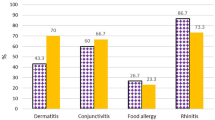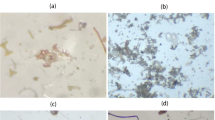Abstract
Allergy to house dust mites (HDMs) can cause allergic rhinitis, allergic asthma and allergic skin disorders, which is becoming an enormous worldwide health and economic burden. To explore the relationship between air pollution and HDMs sensitization in children, this study used immunoblotting to determine the concentration of HDM serum-specific IgE (sIgE) in children with allergic diseases in Hangzhou. HDM sIgE was used to reflect the sensitization of children with HDMs. Using the meteorological and atmospheric pollutant data for Hangzhou, a distributed lag nonlinear model was founded to evaluate the effect of atmospheric pollutants on HDMs sensitization. Particulate matter (PM) 2.5 and PM10 were the main air pollutants in Hangzhou. The positive rate of HDM sIgE in children’s serum increased with increasing PM2.5 and PM10 concentrations, and this effect was most obvious on the seventh and tenth days after increased PM2.5 and PM10 concentrations, respectively. In addition, there was a significant positive correlation between the concentration of HDM sIgE and the total serum IgE concentration. The rate of sensitization to HDMs rose dramatically in the first 3 years after birth. In addition, the period between June and November had the largest number of HDM sIgE-positive patients. Studies have shown that PM2.5 and PM10 are important factors in HDM sensitization, which presented obvious dose effects and lag effects. Children under the age of 3 years were the most susceptible to HDMs, and the period from June to November had a high risk of dust mite exposure. Avoiding exposure to particulate matter may have benefits in preventing HDM sensitization in children.






Similar content being viewed by others
Availability of data and material
Datasets used and/or analyzed during the current study are available from the corresponding author upon reasonable request.
References
Acevedo, N., Zakzuk, J., & Caraballo, L. (2019). House dust mite allergy under changing environments. Allergy Asthma & Immunology Research,11(4), 450–469.
Ahn, K. (2014). The role of air pollutants in atopic dermatitis. Journal of Allergy & Clinical Immunology,134(5), 993–999.
Anderson, H. R., Favarato, G., & Atkinson, R. W. (2013). Erratum to: Long-term exposure to air pollution and the incidence of asthma: Meta-analysis of cohort studies. Air Quality, Atmosphere and Health,6(2), 541–542.
Bonay, M., & Aubier, M. (2007). Air pollution and allergic airway diseases. Médecine Sciences,23(2), 187–192.
Bowatte, G., Lodge, C., Lowe, A. J., Erbas, B., Perret, J., Abramson, M. J., et al. (2015). The influence of childhood traffic-related air pollution exposure on asthma, allergy and sensitization: A systematic review and a meta-analysis of birth cohort studies. Allergy, 70(3), 245–256.
Cheng, M. H., Chen, C. C., Chiu, H. F., & Yang, C. Y. (2014). Fine particulate air pollution and hospital admissions for asthma: A case-crossover study in Taipei. Journal of Toxicology and Environmental Health, Part A, 77(18), 1075–1083.
Cheng, Q., Yang, C. Y., Guo, B. Y., Wei, X., & Liu, M. (2017). Analysis of mechanism of PM2.5 and house dust mite antigen der p1 in attack stage of child asthma. European Review for Medical and Pharmacological Sciences,21(10), 2458–2462.
Ertabaklar, H., Yaman, S., & Ertuğ, S. (2006). Evaluation of the prevalence of house dust mites in house dust sent to the Adnan Menderes university medical faculty parasitology laboratory. Turkiye Parazitol Derg,30(1), 29–31.
Gasparrini, A., & Leone, M. (2014). Attributable risk from distributed lag models. BMC Medical Research Methodology,14(1), 55.
Guarnieri, M., & Balmes, J. R. (2014). Outdoor air pollution and asthma. Lancet,383(9928), 1581–1592.
Huang, F. L., Liao, E. C., & Yu, S. J. (2018). House dust mite allergy: Its innate immune response and immunotherapy. Immunobiology,223(3), 300–302.
Kangmo, A. (2014). The role of air pollutants in atopic dermatitis. Journal of Allergy and Clinical Immunology, 134(5), 993–999.
Kosik-Bogacka, D. I., Kalisinska, E., Henszel, L., & Kuzna-Grygiel, W. (2012). Seasonal dynamics of house dust mites in dust samples collected from sleeping places in north-western poland. Zoonoses and Public Health,59(1), 8–15.
Li, J., Wang, H., Chen, Y., Zheng, J., Wong, G. W., & Zhong, N. (2013). House dust mite sensitization is the main risk factor for the increase in prevalence of wheeze in 13- to 14-year-old schoolchildren in Guangzhou city, China. Clinical and Experimental Allergy,43(10), 1171–1179.
Lilian, T. (2011). Outdoor air pollution and asthma in children. Journal of Asthma, 48(5), 470–481.
Renz, H., Holt, P. G., Inouye, M., Logan, A. C., Prescott, S. L., & Sly, P. D. (2017). An exposome perspective: Early-life events and immune development in a changing world. Journal of Allergy and Clinical Immunology,140(1), 24–40.
Shukla, A., Timblin, C., Berube, K., Gordon, T., Mckinney, W., Driscoll, K., et al. (2000). Inhaled particulate matter causes expression of nuclear factor (NF)-kappaB-related genes and oxidant-dependent NF-kappaB activation in vitro. American Journal of Respiratory Cell and Molecular Biology,23(2), 182–187.
Song, W., Jia, H., Li, Z., & Tang, D. (2018). Using geographical semi-variogram method to quantify the difference between NO2 and PM2.5 spatial distribution characteristics in urban areas. Science of the Total Environment,631–632, 688–694.
Wahn, U., Lau, S., Bergmann, R., Kulig, M., Forster, J., Bergmann, K., et al. (1997). Indoor allergen exposure is a risk factor for sensitization during the first three years of life. Journal of Allergy and Clinical Immunology,99(6), 763–769.
Wang, J. Y. (2013). The innate immune response in house dust mite-induced allergic inflammation. Allergy, asthma & immunology research,5(2), 68–74.
Wang, I. J., Tung, T. H., Tang, C. S., & Zhao, Z. H. (2016). Allergens, air pollutants, and childhood allergic diseases. International Journal of Hygiene and Environmental Health,219(1), 66–71.
WHO (2000). Air quality guidelines for Europe, second edition Copenhagen, WHO Regional Office for Europe, 2000. WHO regional publications, European series; No 91.
WHO (2006a). Air quality guidelines. Global update 2005. World Health Organization 2006.
WHO (2006b). Air quality guidelines for particulate matter, ozone, nitrogen dioxide and sulfur dioxide. Global update 2005. Summary of risk assessment. World Health Organization 2006.
Wilson, J. M., & Platts-Mills, T. A. E. (2018). Home environmental interventions for house dust mite. Journal of Allergy & Clinical Immunology in Practice,6(1), 1–7.
Ye, Q., Fu, J. F., Mao, J. H., & Shang, S. Q. (2016a). Haze is a risk factor contributing to the rapid spread of respiratory syncytial virus in children. Environmental Science and Pollution Research,23(20), 1–8.
Ye, Q., Fu, J. F., Mao, J. H., Shen, H. Q., Chen, X. J., Shao, W. X., et al. (2016b). Haze is an important medium for the spread of rotavirus. Environmental Pollution,216, 324–331.
Zhang, J., Fulgar, C. C., Mar, T., Young, D. E., Zhang, Q., Bein, K. J., et al. (2018). Th17-induced neutrophils enhance the pulmonary allergic response following balb/c exposure to house dust mite allergen and fine particulate matter from California and China. Toxicological Sciences,164(2), 627–643.
Zhang, C., Gjesing, B., Lai, X., Li, J., Spangfort, M. D., & Zhong, N. (2011). Indoor allergen levels in Guangzhou city, southern China. Allergy,66(2), 186–191.
Funding
This project was supported by grants from the National Natural Science Foundation of China (Grant No. 81501760), Zhejiang Provincial Natural Science Foundation of China (Grant No. LQ16H050002) and Zhejiang Provincial Healthy Science Foundation of China (Grant No. 2015KYB191). The funders did not take part in the study.
Author information
Authors and Affiliations
Contributions
JHM conceptualized and designed the study, reviewed and revised the manuscript; QY and TZ conducted the analysis, interpreted the study data and drafted the initial manuscript. All authors critically reviewed and approved the final manuscript as submitted and agree to be accountable for all aspects of the work.
Corresponding author
Ethics declarations
Conflict of interest
The authors declare they have no actual or potential competing financial interests.
Ethical approval and consent to participate
This study was approved by the ethics committee of Children’s Hospital, Zhejiang University School of Medicine, and we obtained informed consent from the guardians of the children.
Additional information
Publisher's Note
Springer Nature remains neutral with regard to jurisdictional claims in published maps and institutional affiliations.
Rights and permissions
About this article
Cite this article
Ye, Q., Zhang, T. & Mao, Jh. Haze facilitates sensitization to house dust mites in children. Environ Geochem Health 42, 2195–2203 (2020). https://doi.org/10.1007/s10653-019-00481-6
Received:
Accepted:
Published:
Issue Date:
DOI: https://doi.org/10.1007/s10653-019-00481-6




